The Intra-Abdominal Infection Treatment Market is estimated to be valued at USD 26.9 billion in 2025 and is projected to reach USD 60.7 billion by 2035, registering a compound annual growth rate (CAGR) of 8.5% over the forecast period.
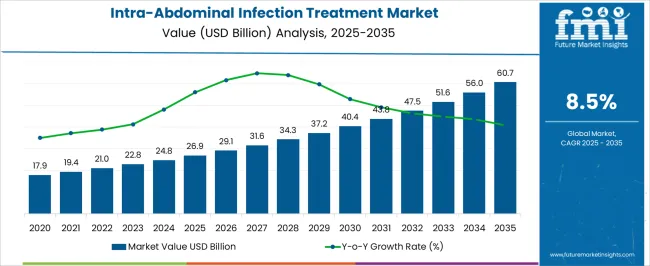
| Metric | Value |
|---|---|
| Intra-Abdominal Infection Treatment Market Estimated Value in (2025 E) | USD 26.9 billion |
| Intra-Abdominal Infection Treatment Market Forecast Value in (2035 F) | USD 60.7 billion |
| Forecast CAGR (2025 to 2035) | 8.5% |
The Intra-Abdominal Infection Treatment market is experiencing steady growth driven by the increasing prevalence of intra-abdominal infections across both developed and emerging regions. The current scenario is shaped by rising awareness of severe complications associated with untreated infections, as well as the need for timely and effective therapeutic interventions.
Expansion in healthcare infrastructure, coupled with advances in diagnostic capabilities, has enabled earlier detection and targeted treatment, thereby improving clinical outcomes. The future outlook for the market is reinforced by continuous innovation in treatment modalities and the adoption of combination therapies, which enhance the effectiveness of existing drugs.
Additionally, the growing emphasis on antimicrobial stewardship and the development of safer and more effective drugs are creating opportunities for market expansion With hospitals and clinical centers prioritizing infection management and evidence-based protocols, the Intra-Abdominal Infection Treatment market is expected to maintain steady growth while accommodating evolving treatment standards and patient-centric approaches.
The intra-abdominal infection treatment market is segmented by drugs, pathogens - gram-positive, pathogens - gram-negative, infection type, end users, and geographic regions. By drugs, intra-abdominal infection treatment market is divided into Antibiotics, Anti-bacterials, Antifungals, Analgesics, and Others. In terms of pathogens - gram-positive, intra-abdominal infection treatment market is classified into Staphylococcus, Enterococcus, Streptococcus, and Others. Based on pathogens - gram-negative, intra-abdominal infection treatment market is segmented into Bacteroides, Clostridium, Proteus, Klebsiella, Pseudomonas, Enterobacter, coli, and Others. By infection type, intra-abdominal infection treatment market is segmented into Community-acquired and Healthcare associated. By end users, intra-abdominal infection treatment market is segmented into Hospitals, Clinics, and Home Settings. Regionally, the intra-abdominal infection treatment industry is classified into North America, Latin America, Western Europe, Eastern Europe, Balkan & Baltic Countries, Russia & Belarus, Central Asia, East Asia, South Asia & Pacific, and the Middle East & Africa.
The antibiotics segment is projected to account for 47.60% of the Intra-Abdominal Infection Treatment market revenue share in 2025, establishing it as the leading drug type. This dominance has been driven by the broad-spectrum activity of antibiotics, which allows effective management of both primary and secondary intra-abdominal infections. The growth of this segment has been reinforced by increasing incidences of hospital-acquired infections and the widespread use of antibiotics in postoperative care.
Treatment protocols increasingly rely on antibiotics due to their proven efficacy in reducing infection severity and improving patient recovery rates. Furthermore, the availability of diverse formulations and combinations has enhanced their flexibility for different clinical scenarios, contributing to high adoption across hospitals and healthcare providers.
The ability to target multiple pathogens with a single therapy, alongside improved administration methods and tolerability, continues to strengthen the position of antibiotics as the cornerstone of intra-abdominal infection management Future growth is expected to be supported by ongoing research into novel antibiotic classes and optimized dosing regimens.
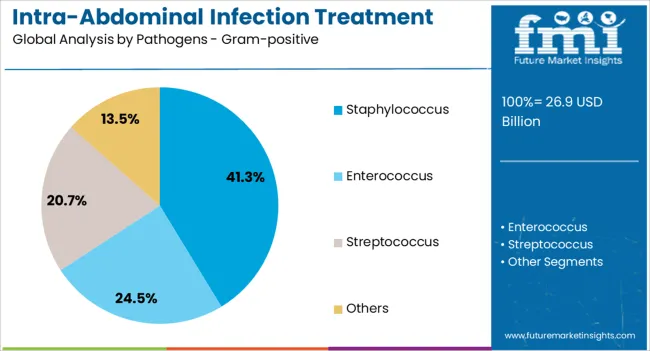
The Gram-positive pathogen segment, with a 41.30% share of the Intra-Abdominal Infection Treatment market in 2025, is leading due to the high prevalence of infections caused by bacteria such as Staphylococcus. The dominance of this segment has been reinforced by the critical role Gram-positive pathogens play in postoperative and hospital-acquired intra-abdominal infections.
Treatment approaches targeting these pathogens are increasingly emphasized due to their association with severe complications and prolonged hospitalization. The growth of this segment is further supported by the rising focus on rapid diagnostics and targeted antimicrobial therapy, which enables more effective infection control and reduces resistance development.
Clinical adoption is being driven by the need for precision in therapeutic interventions and improved patient outcomes As the understanding of pathogen-specific infection dynamics advances, the demand for therapies addressing Gram-positive bacteria is expected to sustain leadership, particularly in hospital settings where high-risk patients require effective and timely intervention.
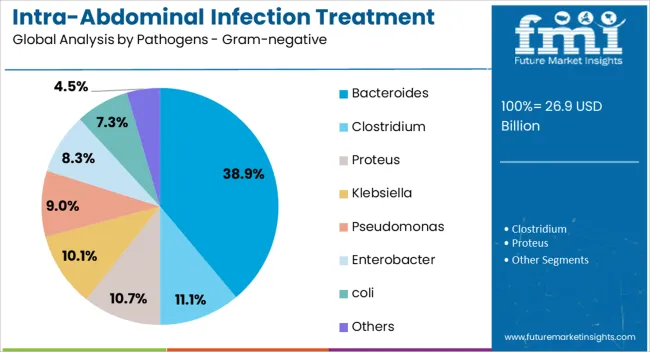
The Gram-negative pathogen segment is expected to hold 38.90% of the Intra-Abdominal Infection Treatment market revenue in 2025, reflecting its significant role in infection management. This growth is being driven by the widespread incidence of Gram-negative bacteria such as Bacteroides in intra-abdominal infections, which are often associated with complex and severe clinical presentations.
The segment has gained prominence due to the increasing need for therapies that effectively target multidrug-resistant strains prevalent in hospital environments. Treatment protocols are evolving to prioritize early detection and pathogen-specific intervention, which has heightened the demand for antibiotics and combination therapies that act against Gram-negative organisms.
Additionally, the integration of advanced diagnostic tools and susceptibility testing has allowed healthcare providers to optimize therapy and improve recovery outcomes With growing clinical awareness of the risks posed by Gram-negative infections, the segment is expected to continue experiencing robust demand, driven by the need for precise, evidence-based infection management strategies.
Intra-abdominal infection are group of infections occurring within the abdominal cavity and vary from appendicitis, peritonitis, diverticulitis, cholecystitis, cholangitis, to pancreatitis characterized by high risk of complication resulting in high mortality despite treatment. According to the Infectious Diseases Society of America (IDSA), Intra-abdominal infection generally extends beyond the organ of origin into the abdominal cavity and is associated with an abscess. Intra-abdominal infections are associated with symptoms such as epigastric pain radiating to the back, vomiting, posterior penetrating ulcer, nausea, decreased appetite and others.
The high prevalence of intra-abdominal infection coupled with the high mortality rates generate a large inelastic demand for the intra-abdominal infection treatment market. Appendicitis is the most common cause of Intra-abdominal infection resulting in more than 300,000 cases each year and over 1 million hospital days. In 2025 about 12.3 million cases of appendicitis were recorded in the USA resulting in more than 340,000 surgeries and about 54,870 deaths. Globally about 7.5% of people have appendicitis at some point in their life.
Mortality rates associated with intra-abdominal infections vary from 3.5% with early infection to more than 60% with well-established infection with multiple organ failure. The high mortality rate of intra-abdominal infections is exemplified by peritonitis which have a mortality rate of about 10% when treated properly. Growing geriatric population is another driver of the intra-abdominal infection treatment market as risk of developing intra-abdominal infection and mortality increases with age. The mortality rate for intra-abdominal infection rises to about 40% in the elderly.
The increasing exposure to bacteria such as staphylococci, Pseudomonas, Candida and Enterococci owing to rising pollution, urbanization is another driver of the intra-abdominal infection treatment market. Rowing resistance to antimicrobials such as penicillin and related beta-lactam antibiotics is another driver of the intra-abdominal infection treatment market value as this necessitates use of expensive antibiotics such as piperacillin, imipenem, ticarcillin, or ciprofloxacin. Diverticulosis affects more than 10% to 25% of the elderly and is the second leading cause of infection-related mortality in the intensive care units.
The growing menace of hospital and surgical acquired infections is a strong driver of the intra-abdominal infection treatment market. Almost 157,500 cases of surgical acquired infections were recorded in the United States per year resulting in approximately 8,205 deaths according to the center for disease control and prevention. Surgical acquired infections account for 11% of all deaths in intensive care units in the USA and account for a whopping $3.2 billion in attributable cost per year according to the center for disease control and prevention 2025 surgical acquired infections updates.
However, the increasing fragmentation of the market owing to penetration of generics is exerting a pricing pressure on the intra-abdominal infection treatment market. The excessive production capacity of antimicrobials is another cause expected to hamper the intra-abdominal infection treatment market.
The global market for intra-abdominal infection treatment is expected to expand owing to growing incidence and the owing to growing stringency of regulations. For example, the Hospital Readmissions Reduction Program (HRRP) established under the Affordable Care Act, penalize hospitals with higher-than-expected readmissions. Under the HRRP, hospitals can incur a penalty of up to 3% of their Medicare payments. The intra-abdominal infection treatment market trends include a definite shift in favor of developing regions of Asia Pacific, such as India and China.
The global intra-abdominal infection treatment market can be classified into the following region: North America, Latin America, Western Europe, Eastern Europe, Asia-Pacific, Japan, Middle East and Africa. North America, led by the USA, is expected to account for the largest share in the global intra-abdominal infection treatment market, owing to the large demand, large healthcare expenditure, and large per capita income in the region.
The Asia Pacific intra-abdominal infection treatment market excluding Japan is projected to expand and dominate the scene in the near future, owing to the growing healthcare and healthcare expenditure. China and India are anticipated to account for the major share of the Asia Pacific intra-abdominal infection treatment market growth. Germany, France and the UK, are projected to be the largest drivers of the Europe intra-abdominal infection treatment market. The Middle East and Africa intra-abdominal infection treatment market is anticipated to be dominated by the gulf economies of Saudi Arabia, Kuwait, UAE and Qatar.
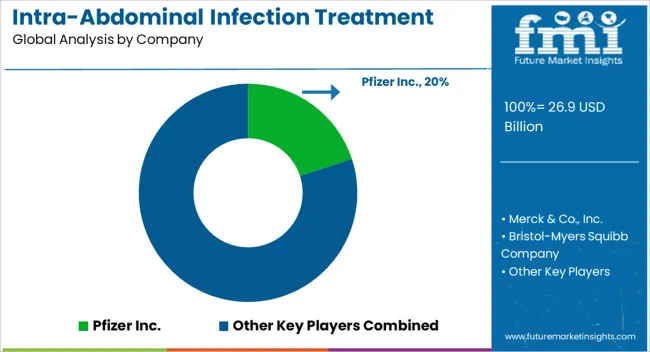
Some of the major vendors operating in the global intra-abdominal infection treatment market are Mylan Pharmaceuticals Inc., Sun Pharmaceutical Industries, Inc., Teva Pharmaceuticals USA, Inc., Dr. Reddy's Laboratories, Merck & Co., Roche Holding AG, GlaxoSmithKline plc, Pfizer Inc., Johnson & Johnson., Sanofi SA., Boehringer Ingelheim GmbH, Eli Lilly and Company and others.
The global intra-abdominal infection treatment report is a compilation of first-hand information, qualitative and quantitative assessment by industry analysts, inputs from industry experts and industry participants across the value chain. The report provides in-depth analysis of parent market trends, macro-economic indicators and governing factors along with market attractiveness as per segments. The report also maps the qualitative impact of various market factors on market segments and geographies.
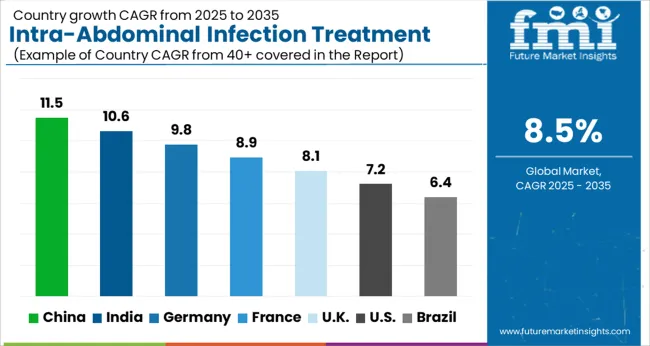
| Country | CAGR |
|---|---|
| China | 11.5% |
| India | 10.6% |
| Germany | 9.8% |
| France | 8.9% |
| UK | 8.1% |
| USA | 7.2% |
| Brazil | 6.4% |
The Intra-Abdominal Infection Treatment Market is expected to register a CAGR of 8.5% during the forecast period, exhibiting varied country level momentum. China leads with the highest CAGR of 11.5%, followed by India at 10.6%. Developed markets such as Germany, France, and the UK continue to expand steadily, while the USA is likely to grow at consistent rates. Brazil posts the lowest CAGR at 6.4%, yet still underscores a broadly positive trajectory for the global Intra-Abdominal Infection Treatment Market. In 2024, Germany held a dominant revenue in the Western Europe market and is expected to grow with a CAGR of 9.8%. The USA Intra-Abdominal Infection Treatment Market is estimated to be valued at USD 10.0 billion in 2025 and is anticipated to reach a valuation of USD 20.2 billion by 2035. Sales are projected to rise at a CAGR of 7.2% over the forecast period between 2025 and 2035. While Japan and South Korea markets are estimated to be valued at USD 1.4 billion and USD 893.1 million respectively in 2025.
| Item | Value |
|---|---|
| Quantitative Units | USD 26.9 Billion |
| Drugs | Antibiotics, Anti-bacterials, Antifungals, Analgesics, and Others |
| Pathogens - Gram-positive | Staphylococcus, Enterococcus, Streptococcus, and Others |
| Pathogens - Gram-negative | Bacteroides, Clostridium, Proteus, Klebsiella, Pseudomonas, Enterobacter, coli, and Others |
| Infection Type | Community-acquired and Healthcare associated |
| End Users | Hospitals, Clinics, and Home Settings |
| Regions Covered | North America, Europe, Asia-Pacific, Latin America, Middle East & Africa |
| Country Covered | United States, Canada, Germany, France, United Kingdom, China, Japan, India, Brazil, South Africa |
| Key Companies Profiled | Pfizer Inc., Merck & Co., Inc., Bristol-Myers Squibb Company, AstraZeneca, Bayer AG, Boehringer Ingelheim International GmbH, Johnson & Johnson Services, Inc., and Novartis AG |
The global intra-abdominal infection treatment market is estimated to be valued at USD 26.9 billion in 2025.
The market size for the intra-abdominal infection treatment market is projected to reach USD 60.7 billion by 2035.
The intra-abdominal infection treatment market is expected to grow at a 8.5% CAGR between 2025 and 2035.
The key product types in intra-abdominal infection treatment market are antibiotics, anti-bacterials, antifungals, analgesics and others.
In terms of pathogens - gram-positive, staphylococcus segment to command 41.3% share in the intra-abdominal infection treatment market in 2025.






Our Research Products

The "Full Research Suite" delivers actionable market intel, deep dives on markets or technologies, so clients act faster, cut risk, and unlock growth.

The Leaderboard benchmarks and ranks top vendors, classifying them as Established Leaders, Leading Challengers, or Disruptors & Challengers.

Locates where complements amplify value and substitutes erode it, forecasting net impact by horizon

We deliver granular, decision-grade intel: market sizing, 5-year forecasts, pricing, adoption, usage, revenue, and operational KPIs—plus competitor tracking, regulation, and value chains—across 60 countries broadly.

Spot the shifts before they hit your P&L. We track inflection points, adoption curves, pricing moves, and ecosystem plays to show where demand is heading, why it is changing, and what to do next across high-growth markets and disruptive tech

Real-time reads of user behavior. We track shifting priorities, perceptions of today’s and next-gen services, and provider experience, then pace how fast tech moves from trial to adoption, blending buyer, consumer, and channel inputs with social signals (#WhySwitch, #UX).

Partner with our analyst team to build a custom report designed around your business priorities. From analysing market trends to assessing competitors or crafting bespoke datasets, we tailor insights to your needs.
Supplier Intelligence
Discovery & Profiling
Capacity & Footprint
Performance & Risk
Compliance & Governance
Commercial Readiness
Who Supplies Whom
Scorecards & Shortlists
Playbooks & Docs
Category Intelligence
Definition & Scope
Demand & Use Cases
Cost Drivers
Market Structure
Supply Chain Map
Trade & Policy
Operating Norms
Deliverables
Buyer Intelligence
Account Basics
Spend & Scope
Procurement Model
Vendor Requirements
Terms & Policies
Entry Strategy
Pain Points & Triggers
Outputs
Pricing Analysis
Benchmarks
Trends
Should-Cost
Indexation
Landed Cost
Commercial Terms
Deliverables
Brand Analysis
Positioning & Value Prop
Share & Presence
Customer Evidence
Go-to-Market
Digital & Reputation
Compliance & Trust
KPIs & Gaps
Outputs
Full Research Suite comprises of:
Market outlook & trends analysis
Interviews & case studies
Strategic recommendations
Vendor profiles & capabilities analysis
5-year forecasts
8 regions and 60+ country-level data splits
Market segment data splits
12 months of continuous data updates
DELIVERED AS:
PDF EXCEL ONLINE
Global Eye Infections Treatment Market Report - Trends & Forecast 2025 to 2035
Yeast Infection Treatment Market by Drug Type, Distribution Channel, End User, and Region, 2025 to 2035
Systemic Infection Treatment Market
Norovirus Infection Treatment Market
Pork Tapeworm Infection Treatment Market Trends – Demand & Innovations 2025 to 2035
Toxoplasmosis Infection Treatment Market
Salivary Gland Infection Treatment Market Size and Share Forecast Outlook 2025 to 2035
Staphylococcal Infection Treatment Market
Coxsackievirus Infections Treatment Market – Growth & Drug Innovations 2025 to 2035
Demand for Yeast Infection Treatment in Japan Size and Share Forecast Outlook 2025 to 2035
Varicella Zoster Infection Treatment Market Size and Share Forecast Outlook 2025 to 2035
Urinary Tract Infection (UTI) Treatment Market (UTI) Analysis - Size, Share, and Forecast 2025 to 2035
Helicobacter Pylori Infections Treatment Market Size and Share Forecast Outlook 2025 to 2035
Global Antibiotic-Resistant Infections Treatment Market Analysis – Size, Share & Forecast 2024-2034
Upper Respiratory Tract Infection Treatment Market
Complicated Urinary Tract Infections Treatment Market - Trends & Outlook 2025 to 2035
Uncomplicated Urinary Tract Infection Treatment Market Analysis by Penicillin, Quinolones, Sulfonamide, Nitrofuran, and Others Through 2035
Market Share Breakdown of Uncomplicated Urinary Tract Infection Treatment
Catheter Associated Urinary Tract Infections (UTI) Treatment Market - Demand & Forecast 2025 to 2035
Treatment-Resistant Hypertension Management Market Size and Share Forecast Outlook 2025 to 2035

Thank you!
You will receive an email from our Business Development Manager. Please be sure to check your SPAM/JUNK folder too.
Chat With
MaRIA